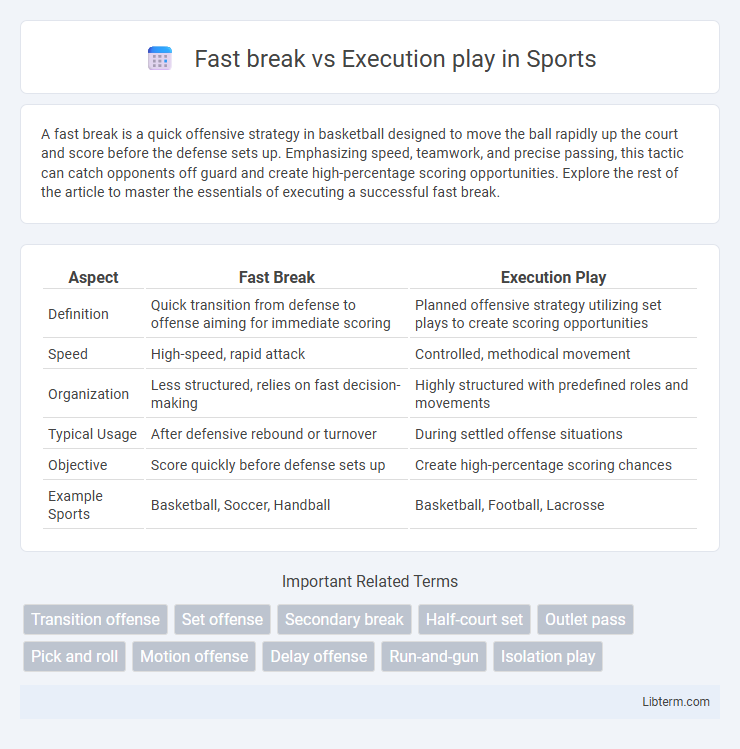A fast break is a quick offensive strategy in basketball designed to move the ball rapidly up the court and score before the defense sets up. Emphasizing speed, teamwork, and precise passing, this tactic can catch opponents off guard and create high-percentage scoring opportunities. Explore the rest of the article to master the essentials of executing a successful fast break.
Table of Comparison
| Aspect | Fast Break | Execution Play |
|---|---|---|
| Definition | Quick transition from defense to offense aiming for immediate scoring | Planned offensive strategy utilizing set plays to create scoring opportunities |
| Speed | High-speed, rapid attack | Controlled, methodical movement |
| Organization | Less structured, relies on fast decision-making | Highly structured with predefined roles and movements |
| Typical Usage | After defensive rebound or turnover | During settled offense situations |
| Objective | Score quickly before defense sets up | Create high-percentage scoring chances |
| Example Sports | Basketball, Soccer, Handball | Basketball, Football, Lacrosse |
Understanding Fast Break Offense
Fast break offense emphasizes rapid transition from defense to offense, aiming to capitalize on unsettled defenses with quick passes and aggressive speed. Execution plays rely on structured, methodical setups designed to create high-percentage scoring opportunities through precise movement and timing. Understanding fast break offense involves recognizing how speed, spacing, and quick decision-making disrupt defensive organization to generate easy scoring chances.
Key Elements of Execution Play
Execution play centers on precise timing, player positioning, and planned movement patterns to effectively break down the defense and create high-percentage scoring opportunities. Key elements include set screens, coordinated passing sequences, and exploiting mismatches to control the pace and spacing of the offense. Unlike fast breaks, execution plays rely on strategic patience and disciplined teamwork to maximize scoring efficiency.
Speed vs Precision: The Core Differences
Fast break emphasizes rapid transition and speed to capitalize on scoring opportunities before the defense sets up, relying on quick decision-making and athleticism. Execution play prioritizes precision, structured positioning, and strategic ball movement to create high-percentage scoring chances through carefully planned actions. The core difference lies in fast break's velocity-driven spontaneity versus execution play's methodical and calculated approach.
Advantages of Fast Break Strategies
Fast break strategies maximize scoring opportunities by exploiting defensive transitions, creating high-percentage shots before the defense sets up. This approach increases game tempo, forcing opponents into mistakes and fatigue through rapid offensive pushes. Teams leveraging fast breaks often gain a psychological edge, maintaining momentum and applying constant pressure on the defense.
Benefits of Execution-Based Offense
Execution-based offense emphasizes precise plays designed to exploit specific defensive weaknesses, leading to higher efficiency and scoring consistency. This method enhances team coordination by relying on practiced strategies that minimize turnovers and optimize shot selection. Effective execution reduces reliance on speed and individual athleticism, enabling teams to control game tempo and manage crucial moments strategically.
When to Use Fast Break in Games
Fast break is most effective during transitions when the opposing team is out of position after a missed shot or turnover, exploiting numerical advantages before the defense sets up. It is ideal for teams with speedy players and strong ball handlers who can quickly advance the ball and create high-percentage scoring opportunities. Coaches should emphasize fast break situations early in the game to capitalize on opponent mistakes and increase scoring momentum.
Situations Favoring Execution Play
Execution plays excel in situations requiring strategic precision and coordinated teamwork, such as set-piece opportunities, late game scenarios, or when the defense is well-organized. These plays capitalize on rehearsed movements and planned tactics to exploit specific weaknesses, ensuring controlled ball movement and higher scoring efficiency. Teams benefit from execution plays during critical moments where patience and accuracy outweigh the speed and spontaneity of a fast break.
Player Roles in Each Approach
Fast break basketball emphasizes quick transitions where guards and wings are responsible for sprinting down the court to score before the defense sets up, capitalizing on speed and agility. Execution plays rely heavily on coordinated positions, with point guards directing offense, centers setting screens, and forwards creating space or cutting strategically to exploit defensive weaknesses. This structured approach demands precise timing and responsibilities, contrasting the spontaneous and fluid player roles in fast break scenarios.
Tactical Adjustments & Coaching Tips
Fast break strategies prioritize quick transitions to exploit defensive disarray, requiring coaches to emphasize sprinting lanes, proper spacing, and rapid decision-making. Execution plays demand precise timing and set patterns, with tactical adjustments focusing on screening angles, ball movement, and exploiting mismatches. Coaches should balance player roles, reinforce communication, and adapt in-game reactions to ensure fluidity between fast breaks and structured executions.
Impact on Team Performance and Outcomes
Fast break strategies significantly enhance team performance by creating quick scoring opportunities through rapid transitions, increasing offensive efficiency and pressure on opponents' defenses. Execution plays emphasize structured, deliberate actions that improve shot selection and reduce turnovers, contributing to consistent scoring and disciplined team dynamics. Combining fast break agility with execution play precision results in balanced offensive outcomes, maximizing scoring potential and overall team success.
Fast break Infographic

 libterm.com
libterm.com